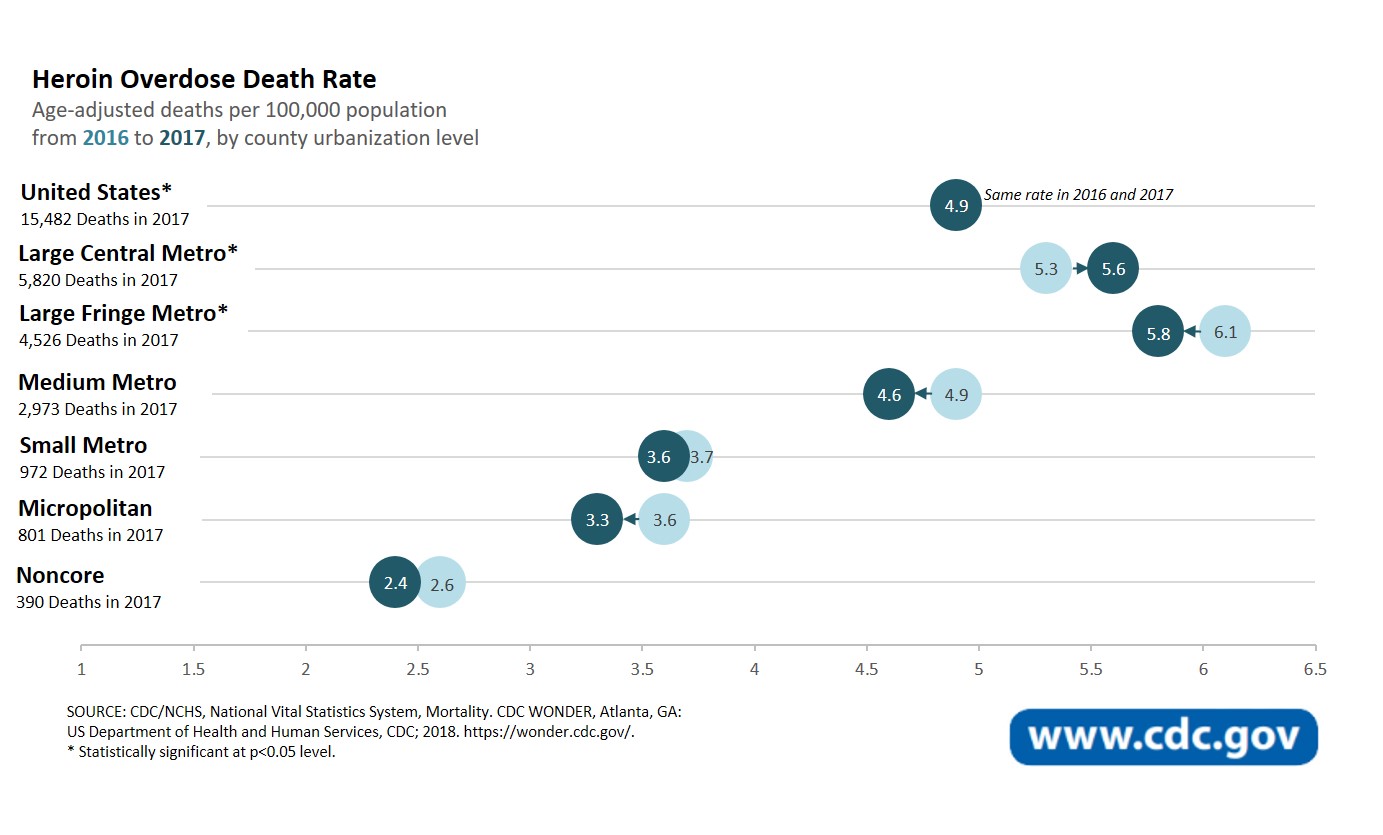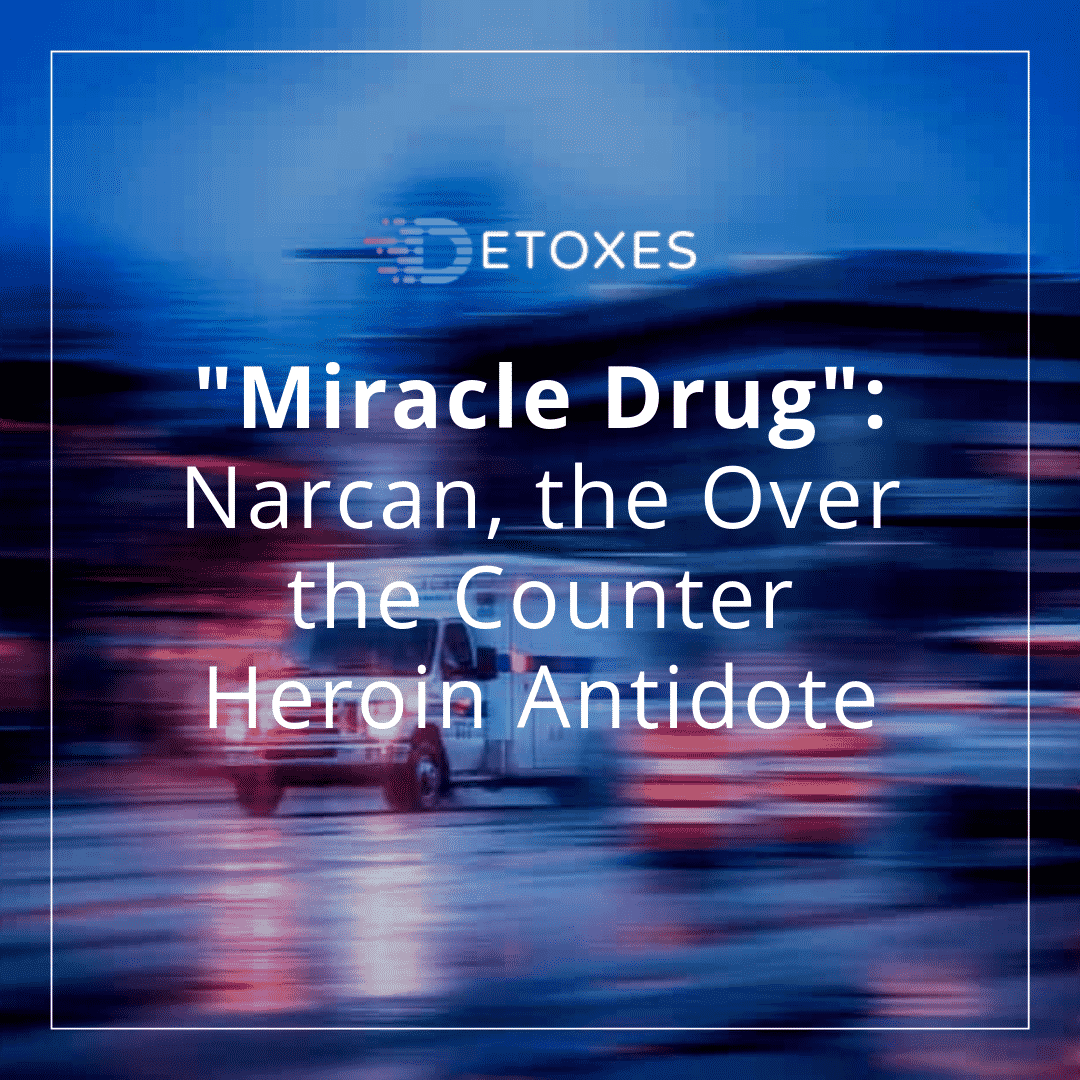“Miracle Drug”: Narcan, the Over the Counter Heroin Antidote
Article Contents
Naloxone (commercially known as Narcan) has been hailed as a “Miracle Drug”6. Not only can it tackle heroin-related overdose and save lives, how it is being used and sold has completely changed.
In the past, Narcan was taken intravenously and by prescription. Recent developments have made it available as a nasal spray, however, making it a lot easier to take and use even at home.
Legislation has also changed in many states meaning that Narcan is also now available over the counter.
Heroin-related overdose statistics
Over the course of the last few years, the rates of heroin-related overdose deaths have only continued to skyrocket. Heroin is a type of opioid and is a common, illegal street-drug. According to statistics from the Centers for Disease Control and Prevention (2018)2, during 2017 alone, over 15,000 people died due to heroin overdose. This death toll increased five times from 2010.
In fact, heroin-related deaths have surpassed gun-related homicides in America8. In 2017, 28,000 deaths involving powerful synthetic opioids (including tramadol and fentanyl) occurred in the United States3. This is the largest amount of deaths caused by any type of opioid.
Here is an infographic on the CDC website clearly demonstrating these rising trends:

However, despite this bill being passed, it seems that little action has been taken on a national level to help combat the steadily rising rates of overdose-related death. While politicians attempt to decide what can be done to curb this growing problem, many states have taken it upon themselves to work towards a solution.
So far, the most beneficial state-by-state contribution to the countrywide opioid crisis has been making the drug naloxone available over the counter. It is an opioid antagonist; a medication that can counteract the deadly effects of an opioid overdose5.
Information about Naloxone
Naloxone was first approved by the FDA in 1971, and has recently gained rampant popularity as a “miracle drug” – one capable of counteracting the effects of a potentially lethal overdose6. It is the standard first-line agent used by doctors in an emergency setting to reverse opioid overdose.
As mentioned above, this drug is an opioid antagonist; meaning that it binds to opioid receptors in the brain and “blocks” other opioids present within the body from binding5. It therefore prevents further intoxication from opioids and effectively counteracts the physical effects of an overdose.
Using the “Miracle Drug”
Naloxone, while originally only offered as an intravenous injection, is now available in an intranasal form without needing a prescription1 in most states. Alternatively, it is available as an intramuscular dose. The intranasal form in particular makes administering the drug exceptionally simple. Legislators have also begun to change laws which prohibit anyone without a medical license/prior training from administering the drug.
While the majority of states now sell Narcan over the counter at either CVS or Walgreens, it is not yet available everywhere. Even those that are able to purchase the drug may not legally be able to administer it. Administering the drug without the necessary credentials could leave you open to fines from state or local governments. Make sure you look into the accessibility and legality within your own specific region.
Current Policies on the “Miracle Drug”
Hopefully, in the near future, Narcan will be available in all states, and available for all to use when necessary. The opioid antagonist has already saved countless lives, proving itself to be a major competitor in the fight against heroin and opioid addiction. A review of the literature showed that take-home naloxone programmes reduced overdose mortality rates, and also had a low incidence of adverse drug effects7.
Policy makers should also take note of the fact that interventions such as at-home naloxone administration is cost-effective. An analysis by Coffin & Sullivan (2013)4 showed that distribution of take-home naloxone kits was cost-effective even under highly conservative assumptions.
Criminalization only further dissuades struggling individuals from seeking necessary help.
The widespread social stigma pertaining to Narcan use, and heroin addiction itself, only drives a larger wedge between the individuals that direly need help and accessibility of crucial services. After all, the statistics and dire death tolls speak for themselves. Those who are suffering from life-threatening heroin addiction are more inclined to hide their problems from others, resulting in a high propensity to escalate to overdose-related death.
References
- ADAPT Pharma. (2018). How to get Narcan. Retrieved March 8, 2019 from https://www.narcan.com/patients/how-to-get-narcan/#isi_anchor
- Centers for Disease Control and Prevention. (2018). Heroin Overdose Data. Retrieved March 8, 2019 from https://www.cdc.gov/drugoverdose/data/heroin.html
- Centers for Disease Control and Prevention. (2018). Synthetic Opioid Overdose Data. Retrieved March 8, 2019 from https://www.cdc.gov/drugoverdose/data/fentanyl.html
- Coffin, P.O. & Sullivan, S.D. (2013). Cost-effectiveness of distributing naloxone to heroin users for lay overdose reversal. Ann Intern Med, 1; 158(1):1-9
- Jauncey, M. E., & Nielsen, S. (2017). Community use of naloxone for opioid overdose. Australian Prescriber, 40(4), 137-140.
- Merlin, M. A., Ariyaprakai, N., & Arshad, F. H. (2015). Assessment of the safety and ease of use of the naloxone auto-injector for the reversal of opioid overdose. Open Access Emergency Medicine, 7, 21-4. doi:10.2147/OAEM.S82133
- McDonald, R., & Strang, J. (2016). Are take-home naloxone programmes effective? Systematic review utilizing application of the Bradford Hill criteria. Addiction, 111(7), 1177-87.
- Siegal, E. (2018). Opioid Epidemic So Dangerous, Says CDC, It’s Finally Killing As Many Americans As Guns. Retrieved March 8, 2019 from
https://www.forbes.com/sites/startswithabang/2018/03/20/opioid-epidemic-so-dangerous-says-cdc-its-finally-killing-as-many-americans-as-guns/#644a274d6c21 - U.S. Department of Health & Human Services. (2018). HHS Awards Over $1 Billion to Combat the Opioid Crisis. Retrieved March 8, 2019 from https://www.hhs.gov/about/news/2018/09/19/hhs-awards-over-1-billion-combat-opioid-crisis.html




